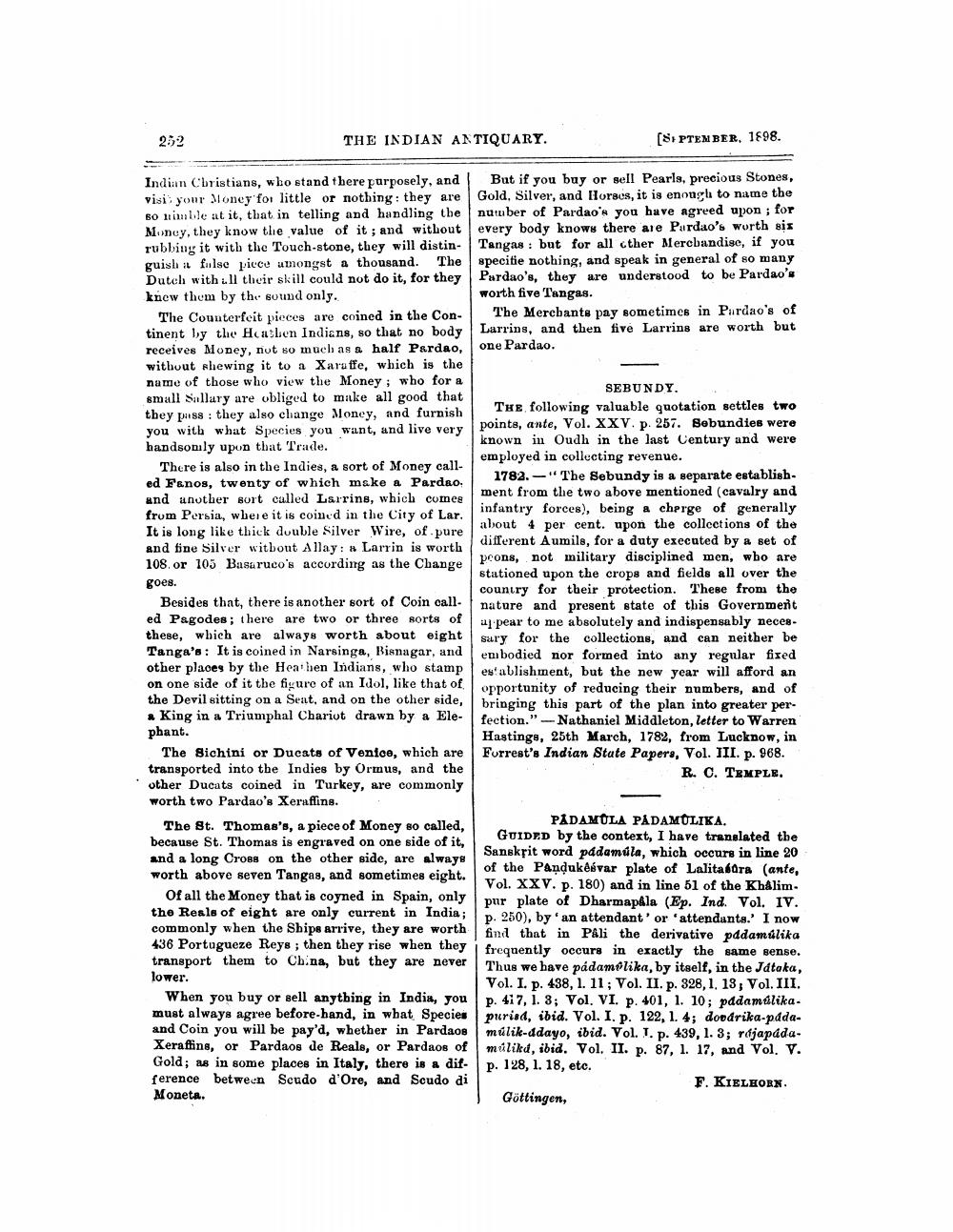________________
252
THE INDIAN ANTIQUARY.
Indian Christians, who stand there purposely, and visi your Money for little or nothing: they are so nimble at it, that in telling and handling the Money, they know the value of it; and without rubbing it with the Touch-stone, they will distinguish a false piece amongst a thousand. The Dutch with all their skill could not do it, for they knew them by the sound only.
The Counterfeit pieces are coined in the Continent by the Heathen Indians, so that no body receives Money, not so much as a half Pardao, without shewing it to a Xaraffe, which is the name of those who view the Money; who for a small Sallary are obliged to make all good that they pass they also change Money, and furnish you with what Species you want, and live very handsomly upon that Trade.
There is also in the Indies, a sort of Money called Fanos, twenty of which make a Pardao. and another sort called Larrins, which comes
from Persia, where it is coined in the City of Lar. It is long like thick double Silver Wire, of pure and fine Silver without Allay: a Larrin is worth 108. or 105 Basaruco's according as the Change
goes.
Besides that, there is another sort of Coin call. ed Pagodes; there are two or three sorts of these, which are always worth about eight Tanga's: It is coined in Narsinga, Bisnagar, and other places by the Heathen Indians, who stamp on one side of it the figure of an Idol, like that of the Devil sitting on a Seat, and on the other side, a King in a Triumphal Chariot drawn by a Elephant.
The Sichini or Ducats of Venice, which are transported into the Indies by Ormus, and the other Ducats coined in Turkey, are commonly worth two Pardao's Xeraffins.
The St. Thomas's, a piece of Money so called, because St. Thomas is engraved on one side of it,
and a long Cross on the other side, are always worth above seven Tangas, and sometimes eight.
Of all the Money that is coyned in Spain, only the Reals of eight are only current in India; commonly when the Ships arrive, they are worth 436 Portugueze Reys; then they rise when they transport them to China, but they are never lower.
When you buy or sell anything in India, you must always agree before-hand, in what Species and Coin you will be pay'd, whether in Pardaos Xeraffins, or Pardaos de Reals, or Pardaos of Gold; as in some places in Italy, there is a difference between Scudo d'Ore, and Scudo di Moneta.
[SPTEMBER, 1898.
But if you buy or sell Pearls, precious Stones, Gold, Silver, and Horses, it is enough to name the number of Pardao's you have agreed upon; for every body knows there are Pardao's worth six Tangas: but for all other Merchandise, if you specifie nothing, and speak in general of so many Pardao's, they are understood to be Pardao's worth five Tangas.
The Merchants pay sometimes in Pardao's of Larrins, and then five Larrins are worth but one Pardao.
SEBUNDY.
THE following valuable quotation settles two points, ante, Vol. XXV. p. 257. Sebundies were known in Oudh in the last Century and were employed in collecting revenue.
1782.The Sebundy is a separate establishment from the two above mentioned (cavalry and infantry forces), being a charge of generally about 4 per cent. upon the collections of the different Aumils, for a duty executed by a set of
peons, not military disciplined men, who are stationed upon the crops and fields all over the country for their protection. These from the nature and present state of this Government appear to me absolutely and indispensably necessary for the collections, and can neither be embodied nor formed into any regular fixed establishment, but the new year will afford an opportunity of reducing their numbers, and of bringing this part of the plan into greater perfection."-Nathaniel Middleton, letter to Warren Hastings, 25th March, 1782, from Lucknow, in Forrest's Indian State Papers, Vol. III. p. 968. R. C. TEMPLE.
PADAMULA PADAMULIKA.
GUIDED by the context, I have translated the Sanskrit word pddamúla, which occurs in line 20 of the Pandukêévar plate of Lalitasûra (ante, Vol. XXV. p. 180) and in line 51 of the Khâlimpur plate of Dharmapala (Ep. Ind. Vol. IV. p. 250), by an attendant' or 'attendants.' I now find that in Pali the derivative pddamúlika frequently occurs in exactly the same sense. Thus we have pádamolika, by itself, in the Játaka, Vol. I. p. 438, 1. 11; Vol. II. p. 328, 1, 13, Vol. III. p. 417, 1. 3; Vol. VI. p. 401, 1. 10; padamúlika. purisd, ibid. Vol. I. p. 122, 1. 4; dovdrika-padamúlik-ddayo, ibid. Vol. I. p. 439, 1. 3; rajapádamúlikd, ibid. Vol. II. p. 87, 1. 17, and Vol. V. p. 128, 1. 18, etc.
F. KIELHORN.
Göttingen,




